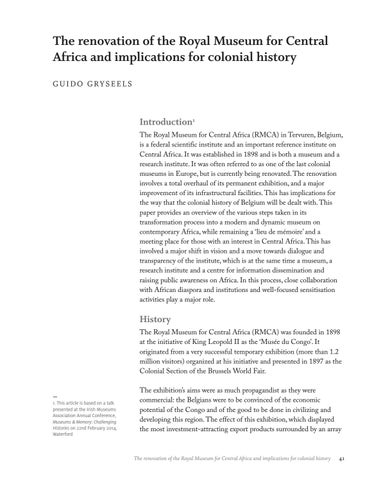The renovation of the Royal Museum for Central Africa and implications for colonial history GUIDO GRYSEELS
Introduction1 The Royal Museum for Central Africa (RMCA) in Tervuren, Belgium, is a federal scientific institute and an important reference institute on Central Africa. It was established in 1898 and is both a museum and a research institute. It was often referred to as one of the last colonial museums in Europe, but is currently being renovated. The renovation involves a total overhaul of its permanent exhibition, and a major improvement of its infrastructural facilities. This has implications for the way that the colonial history of Belgium will be dealt with. This paper provides an overview of the various steps taken in its transformation process into a modern and dynamic museum on contemporary Africa, while remaining a ‘lieu de mémoire’ and a meeting place for those with an interest in Central Africa. This has involved a major shift in vision and a move towards dialogue and transparency of the institute, which is at the same time a museum, a research institute and a centre for information dissemination and raising public awareness on Africa. In this process, close collaboration with African diaspora and institutions and well-focused sensitisation activities play a major role.
History The Royal Museum for Central Africa (RMCA) was founded in 1898 at the initiative of king Leopold II as the ‘Musée du Congo’. It originated from a very successful temporary exhibition (more than 1.2 million visitors) organized at his initiative and presented in 1897 as the Colonial Section of the Brussels World Fair.
— 1. This article is based on a talk presented at the Irish Museums Association Annual Conference, Museums & Memory: Challenging Histories on 22nd February 2014, Waterford
The exhibition’s aims were as much propagandist as they were commercial: the Belgians were to be convinced of the economic potential of the Congo and of the good to be done in civilizing and developing this region. The effect of this exhibition, which displayed the most investment-attracting export products surrounded by an array
The renovation of the Royal Museum for Central Africa and implications for colonial history
41













